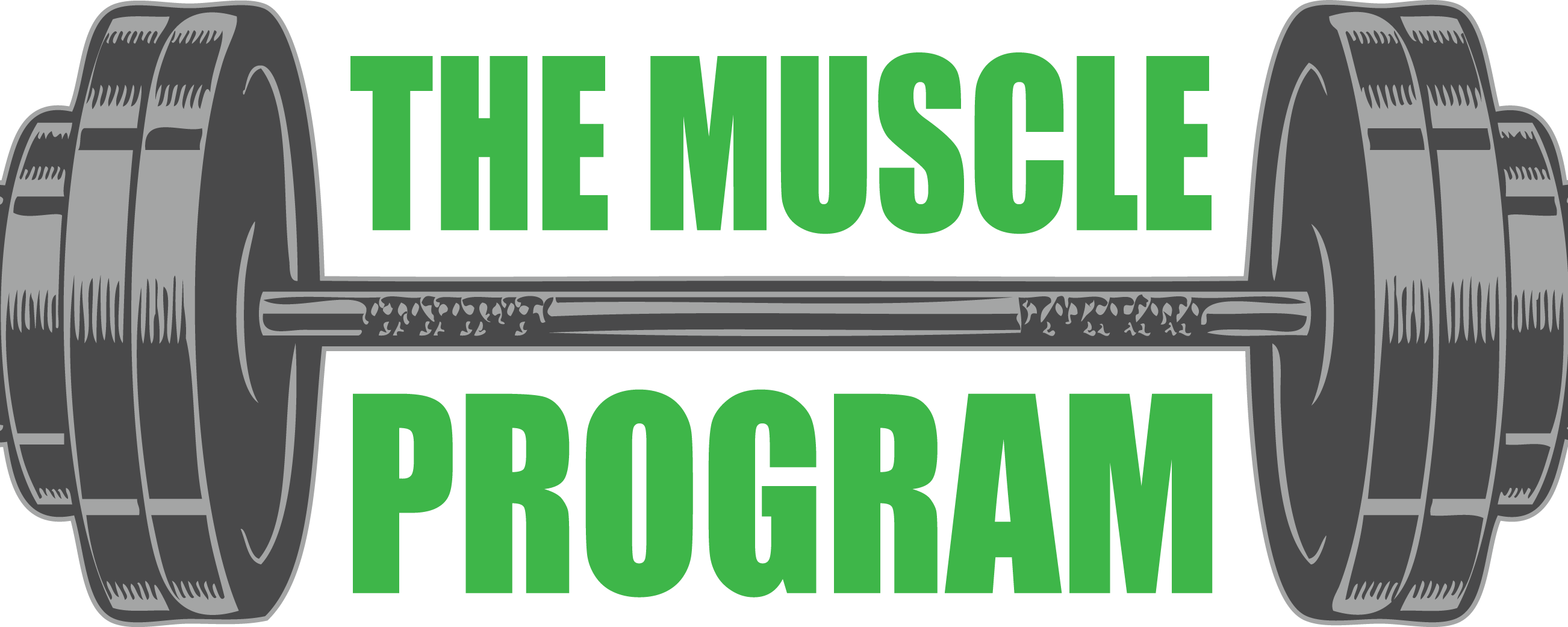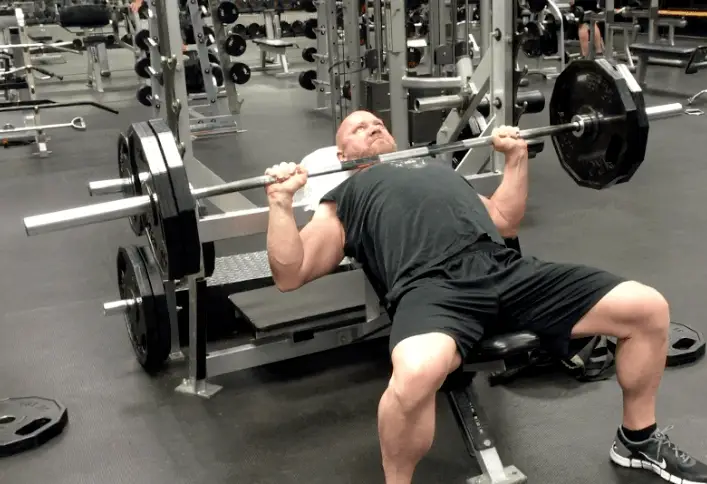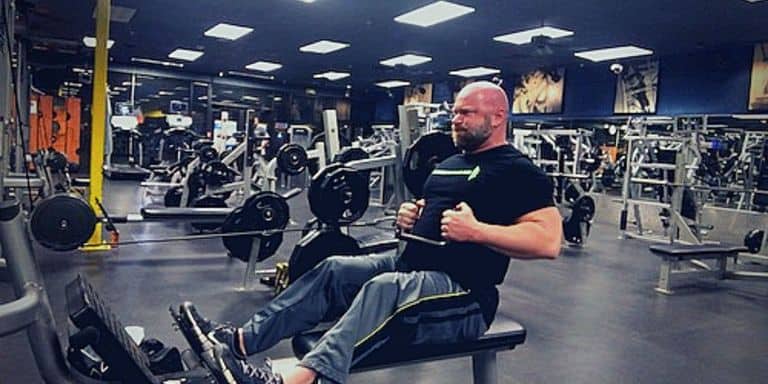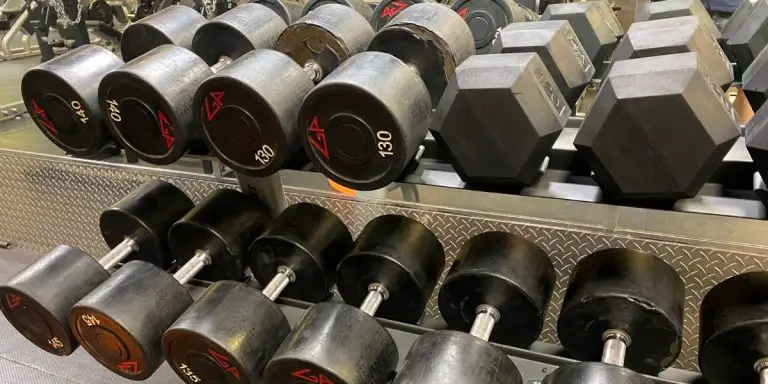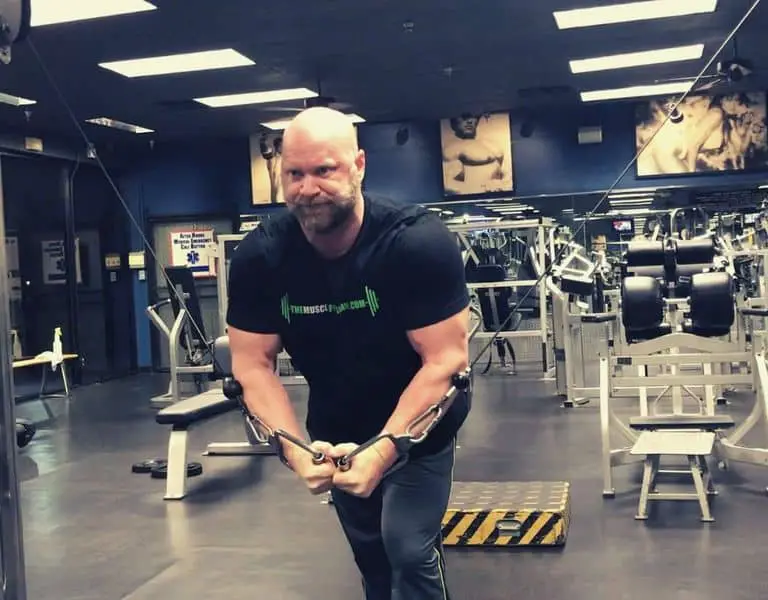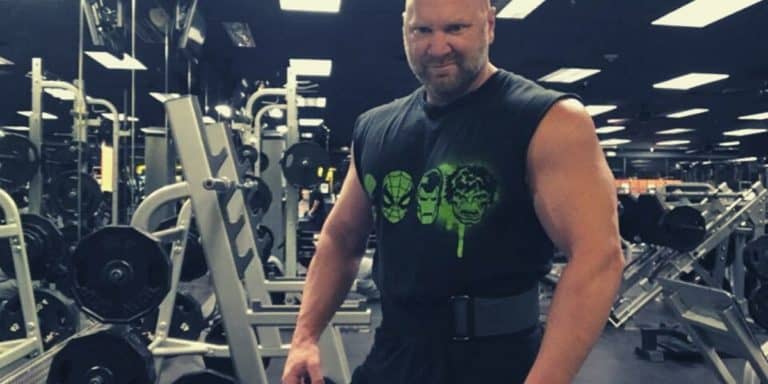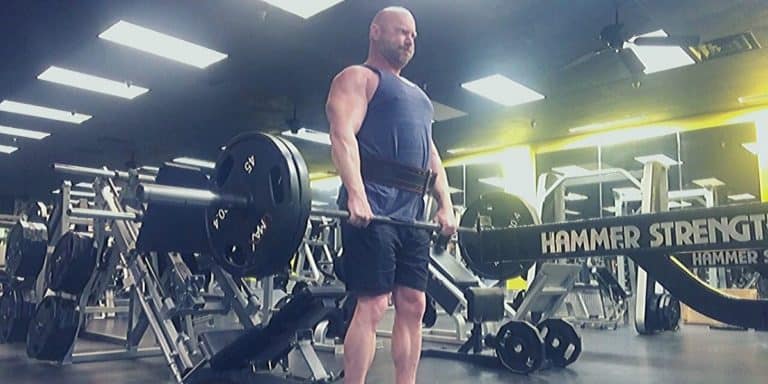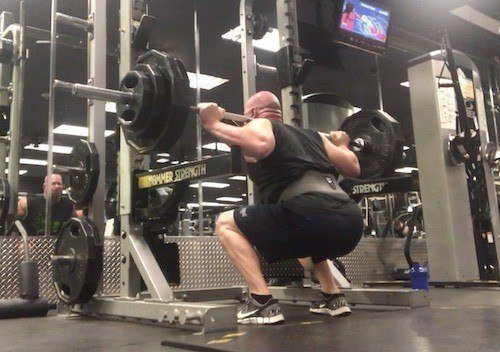Complete Powerbuilding Program: Build Strength, Muscle Size and Symmetry
Let’s be real about something…if you’re strong, you want to look strong. And if you look strong, you want to actually be strong. Right?
Often times we’ll focus on one or the other – strength vs muscle size and symmetry. But what if you want both?
I’m going to show you how to get bigger and stronger with powerbuilding workouts.
In fact, you’re going to get a complete guide to powerbuilding with 3 powerbuilding programs in this post. I’ll also share the best nutrition plan with you so that you can get the most out of these workouts.
Contents
Intro: What is Powerbuilding?
Benefits of Powerbuilding Workouts
3 Power Building Routines and How to Use The for Maximum Gains
Routine 1: 5-3-1
Routine 2: 3 x 3
Routine 3: 5 x 5
Cardio and Powerbuilding: What You Should Do
Nutrition Guide
1-Day Meal Plan Strategy
Supplement Guide
Fastest Way to Gain Size and Strength
Intro: What Is Powerbuilding?
In short, powerbuilding is a combination of powerlifting and bodybuilding techniques performed in the same workout. The goal is to progressively get stronger while building your physique like a bodybuilder.
Before we dive into powerbuilding, let’s quickly cover the core differences between powerlifting and bodybuilding…
Powerlifting is all about lifting maximum weight. Those who compete in professional powerlifting could care less about muscle size or definition. In fact, some powerlifters claim that having bigger muscles can get in the way of their goal.
Powerlifters are also okay with carrying some body fat. Or at least they’re not concerned about getting ripped like a bodybuilder. It’s all about pure strength. And they’re training and nutrition cater to that goal.
Bodybuilding is all about hypertrophy, which leads to muscle size, shape, and symmetry. This doesn’t necessarily mean bodybuilders shy away from lifting heavyweights. But their focus is on forcing the muscles to lift the weights over how much weight is lifted.
Bodybuilding training and nutrition are both centered around building as much muscle as possible while keeping body fat super low. That last part conflicts with strength gains.
| Powerlifting | Bodybuilding |
|---|---|
| Low reps | 8-12 rep ranges |
| Lift maximum weight | Forcing the muscle to work harder |
| Excessive calories to support strength gains | Strict diet that supports muscle definition and low body fat |
| Focused on compound and supporting lifts | Focused on targeting the specific muscle |
Powerbuilding is combining the best parts of powerlifting and bodybuilding to help you gain muscle size and also help you get stronger on your main compound lifts.
Here’s the basic structure of a powerbuilding workout:
- You’ll start your workouts by focusing on strength gains.
- After that, you’ll merge into more concentrated movements and exercises that will promote size and shape.
Benefits of Powerbuilding Workouts
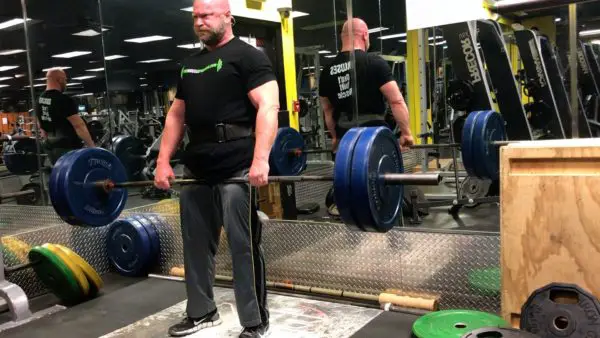
If you’re like me, you’re sometimes on the fence of whether you want to focus on training for strength or building muscle size. So you’re caught between bodybuilding vs. powerlifting.
Here are some benefits of powerbuilding workouts to consider:
- You’ll look strong, and be strong
- You won’t have the tendency to carry the body fat that you see many powerlifters have
- Whereas your diet maybe a little more lenient (in consuming more calories for strength), your mixed focus on bodybuilding will keep you from getting out of control
- It’s a natural way to increase your testosterone, with the combination of heavyweights and training volume for size (if you’re interested in boosting your testosterone, read about my recommended test booster here).
While most that compete at a professional level do focus on one or the other, there’s one great example of someone who’s been successful at both, at the pro level in the early to mid-2000s…
IFBB pro bodybuilder Johnnie Jackson has won both bodybuilding and powerlifting competitions and has been considered pound for pound the strongest bodybuilder (Johnnie goes more in-depth with his training style in his interview with David Robson on bodybuilding.com).
**It’s important to understand that people like Johnnie Jackson are rare exceptions. Most at the pro level of either are going to focus on that one specific goal.
How to Know if Powerbuilding is for You
Powerbuilding is for you if…
- you’re a recreational lifter (like most of us)
- you want to be well-rounded in your strength and physique
- you’re not competing in either powerlifting or bodybuilding (meaning if you are training for a competition, you need to focus on that specific goal for that duration)
- you simply want to be bigger, stronger, and have visible, ripped muscle
What you’ll find with the mass monsters of professional bodybuilding is that most of them built their dense muscle mass from powerlifting in their early days. This allowed them to build more size later by being able to lift heavier weights with more reps and volume.
Some bodybuilders will compete in powerlifting from time to time. Typically in the off-season when calorie surplus is accepted (you obviously would not want to attempt powerlifting while training for a bodybuilding competition!).
Bodybuilders have an advantage here because they can dial is back down with cardio and tightening up their diet to get back in shape.
However, you won’t find many powerlifters that compete in bodybuilding. The required calorie restrictions when prepping for a bodybuilding contest would compromise their strength and power.
But like I mentioned earlier, most recreational gym rats (myself included) don’t compete in powerlifting or bodybuilding. At least not at a pro-level.
We all aspire to be big and strong, and muscular. We don’t want layers of fat covering up our hard-earned muscle. We also don’t want to be that guy that looks huge but is struggling with squatting 185.
Blatantly, we want more muscle definition than what the average powerlifter has, and a little stronger than the typical bodybuilder (or at least be in the elite in your gym).
I’ve personally never had any interest in competing in bodybuilding or powerlifting. So if you’re the same as me, then powerbuilding is perfect for you.
3 Powerbuilding Routines
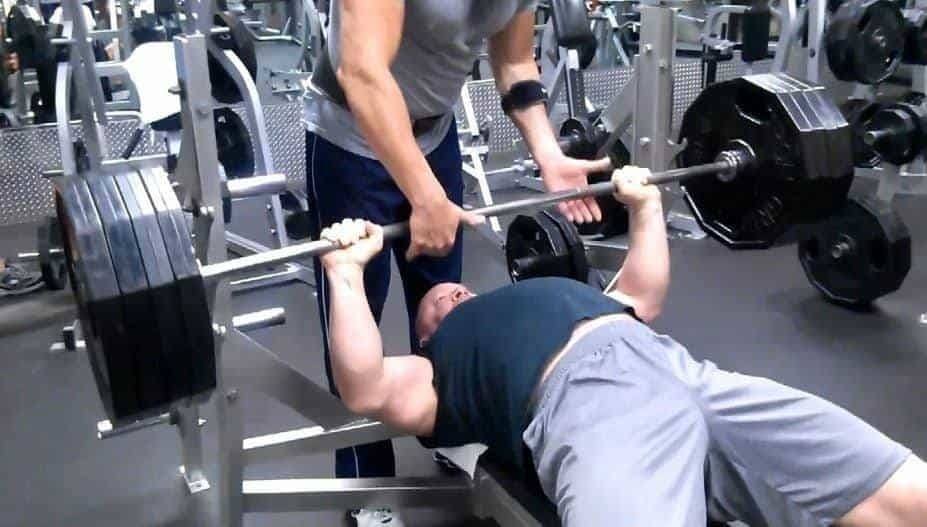
It’s time to jump into your powerbuilding workouts. In fact, I’m sharing three powerbuilding routines with you.
The intent is for you to stay on each routine for four weeks, making this a complete 12-week powerbuilding program.
Each routine will have a slightly different approach that includes both powerlifting and bodybuilding techniques. The goal is to keep your strength gains moving up and to continuously add more muscle size.
Here are a few notes before getting started…
- As you’ll see in the names of the routines below, each workout is based on a powerlifting method and this is how each workout will begin.
- Unlike true powerlifting, you will only be doing your core compound lifts once, no more than twice a week (this is to leave more room for other exercises that will promote muscle size and definition).
- Though you’ll start with a heavy compound lift, the bulk (no pun intended!) of your workouts will be based on hypertrophy, aka bodybuilding.
- These workouts may be a bit more exhausting than what you’re used to because of the heavy lifting combined with more training volume.
- You’ll be training four days a week with each powerbuilding routine.
Now let’s get to your powerbuilding workouts!
Powerbuilding Workout 1: 5-3-1
The 5-3-1 workout method was founded by Jim Wendler, who created this training style (actually called Beyond 5-3-1) because he was tired of being a fat powerlifter. The program is based on ending your final week of doing sets of 5, 3, then 1 max rep set.
There are some variations of that in the weeks leading up to that final week. But I won’t get into that because I want to focus on the powerbuilding workout below.
**If you want to read the details of the original 5-3-1 workout program, you can read it on powerliftingtowin.com.
The powerbuilding workout I’m giving you below uses just the core part of the 5-3-1 workout. Essentially, you’ll do this with your compound exercises, which will be at the beginning of your workout.
After the heavy lifting, you’re going to go right into a bodybuilding style of training.
Here’s your training split (you can modify this to cater to your schedule):
- Monday: Workout 1
- Tuesday: Workout 2
- Wednesday: Rest
- Thursday: Workout 3
- Friday: Workout 4
- Saturday & Sunday: Rest
Workout 1: Back and Biceps
| Exercises | Sets x Reps |
|---|---|
| Deadlifts | 3 x 5, 3, 1 |
| Barbell Rows | 3 x 5, 3, 1 |
| Seated Rows | 4 x 8 |
| Lat Pulldowns | 4 x 10** |
| Barbell Curls | 3 x 8 |
| Dumbbell Hammer Curls | 3 x 10** |
**Do a drop set on the final set
Workout 2: Chest and Triceps
| Exercises | Sets x Reps |
|---|---|
| Bench Press | 3 x 5, 3, 1 |
| Incline Bench Press | 4 x 8 |
| Dumbbell Flyes | 4 x 10 |
| Cable Flyes | 4 x 10** |
| Skull Crushers | 3 x 8 |
| Rope Pressdowns | 3 x 10** |
**Do a drop set on the final set
Workout 3: Legs
| Exercises | Sets x Reps |
|---|---|
| Squats | 3 x 5, 3, 1 |
| Deadlifts | 3 x 5, 3, 1 |
| Leg Press | 5 x 12 |
| Leg Extensions | 4 x 12** |
| Leg Curls | 4 x 12** |
| Seated Calve Raises | 4 x 12** |
**Do a drop set on the final set
Workout 4: Shoulders and Light Back
| Exercises | Sets x Reps |
|---|---|
| Overhead Barbell Press | 3 x 5, 3, 1 |
| Seated Dumbbell Press | 4 x 8 |
| Lateral Raises | 4 x 10** |
| Bent-over Raises | 4 x 10** |
| Reverse Grip Barbell Row | 3 x 15 |
| Pull-ups | 3 x 15 |
**Do a drop set on the final set
Powerbuilding Workout 2: 3 x 3
The typical 3 x 3 workout program is based on working agonist and antagonist muscles together. For example, if you did a set of bench press you would do a set of barbell rows after that.
These aren’t necessarily supersets, as the recommended rest is 90 seconds between all sets, per elitefts.com, which goes into further detail.
In the powerbuilding workout below, you’re going to start out with the 3 x 3 strength training method. You’ll do this for two exercises in the beginning of your workout followed by hypertrophy training.
**For your squats and deadlifts, you’ll be going to an abdominal exercise (you’ll obviously do more than 3 reps for those ab exercises!).
Here’s what your workout schedule will look like (similar to the 5-3-1 powerbuilding workout)…
- Monday: Workout 1
- Tuesday: Workout 2
- Wednesday: Rest
- Thursday: Workout 3
- Friday: Workout 4
- Saturday & Sunday: Rest
Workout 1: Lower Body
| Exercises | Sets x Reps |
|---|---|
| Squats | 3 x 3 |
| Leg Raises | 3 x 12 |
| Deadlifts | 3 x 3 |
| Crunches | 3 x 12 |
| Leg Press | 4 x 12 |
| Stiff-Leg Deadlifts | 4 x 12 |
| Seated Calve Raises | 5 x 15 |
Workout 2: Upper Body
| Exercises | Sets x Reps |
|---|---|
| Barbell Rows | 3 x 3 |
| Bench Press | 3 x 3 |
| Seated Rows | 4 x 10 |
| Incline Bench Press | 4 x 10 |
| Barbell Curls | 3 x 10 |
| Cable Pressdowns | 3 x 10 |
Workout 3: Lower Body
| Exercises | Sets x Reps |
|---|---|
| Squats | 3 x 3 |
| Leg Raises | 3 x 12 |
| Deadlifts | 3 x 3 |
| Crunches | 3 x 12 |
| Leg Extensions | 4 x 12 |
| Leg Curls | 4 x 12 |
| Standing Calve Raises | 5 x 15 |
Workout 4: Upper Body
| Exercises | Sets x Reps |
|---|---|
| Barbell Rows | 3 x 3 |
| Overhead Barbell Press | 3 x 3 |
| Lat Pulldowns | 4 x 10 |
| Seated Dumbbell Press | 4 x 10 |
| Pull-ups | 3 x 10 |
| Dips | 3 x 10 |
**For similar workouts, check out my post called 9 Bodybuilding Workouts for Mass Gains
Powerbuilding Workout 3: 5 x 5
One of my personal favorite strength training methods is 5 x 5. The beauty of 5 x 5 is you don’t need a lot more than what it is.
In doing 5 sets of 5 reps, you’re getting a decent amount of volume. So you will not be doing as many bodybuilding exercises after doing the 5 x 5 for your compound movements.
The typical 5 x 5 workout is a 3-day a week program, and like the other powerlifting methods used so far, the focus is on the core compound exercises:
- Squats
- Deadlifts
- Barbell Rows
- Bench Press
- Overhead Barbell Press
The true 5 x 5 has an A and B workout, which are alternated.
Of course, this powerbuilding 5 x 5 workout will be different. But out of the 3 powerbuilding workouts here, this one has more heavy lifting involved.
To be consistent with the other powerbuilding workouts above, this one’s also a 4-day a week training schedule:
- Monday: Workout 1
- Tuesday: Workout 2
- Wednesday: Rest
- Thursday: Workout 3
- Friday: Workout 4
- Saturday & Sunday: Rest
Workout 1: Back and Chest
| Exercises | Sets x Reps |
|---|---|
| Barbell Rows | 5 x 5 |
| Bench Press | 5 x 5 |
| Dumbbell Rows | 4 x 8 |
| Incline Dumbbell Press | 4 x 8 |
Workout 2: Lower Body
| Exercises | Sets x Reps |
|---|---|
| Squats | 5 x 5 |
| Deadlifts | 5 x 5 |
| Leg Extensions | 3 x 12 |
| Leg Curls | 3 x 12 |
| Standing Calve Raises | 5 x 15 |
Workout 3: Back, Shoulders, and Arms
| Exercises | Sets x Reps |
|---|---|
| Barbell Rows | 5 x 5 |
| Overhead Barbell Press | 5 x 5 |
| Barbel Curls | 4 x 12 |
| Close-grip Bench Press | 4 x 12 |
Workout 4: Lower Body
| Exercises | Sets x Reps |
|---|---|
| Deadlifts | 5 x 5 |
| Front Squats | 5 x 5 |
| Leg Extensions | 4 x 12 |
| Leg Curls | 4 x 12 |
| Seated Calve Raises | 5 x 12 |
Cardio on a Powerbuilding Program
Should you do cardio on a powerbuilding routine?
No matter what type of training program you’re on, you should be doing some sort of cardiovascular exercise 3-4 times a week. That’s not only to keep your body fat down but also for heart-health.
How much cardio really depends on your current fitness level and physique, and where you aspire to be. So you have to be honest with yourself.
- If you’re on the heavy side, try doing a 30-minute cardio session 4-5 times a week.
- If you’re already in good shape but wanting to put on more size, see how 3-4 times a week works for you.
Since your weight training is intense and taxing on your body, I suggest sticking to some type of moderate cardio. Here are some things you can do…
- Walk outside
- Walk on the treadmill
- Do the elliptical
- Ride the recumbent bike
- Do the stairclimber
Now, you may be one of those who feel that cardio is boring and you may have a hard time motivating yourself to do it.
One obvious way to push through that is listening to music during cardio, as typical as that sounds.
But I’ve found a better way to stay motivated during cardio…
Listening to a podcast or some type of media where you’re learning something while you do cardio. I call these my learn and burn sessions!
This helps keep your mind stimulated so that you’re not focusing on the boredom of cardio. And you’re also getting in shape while you’re learning something at the same time.
I can’t think of a better way to enhance your mind and body, simultaneously!
Powerbuilding Nutrition Plan
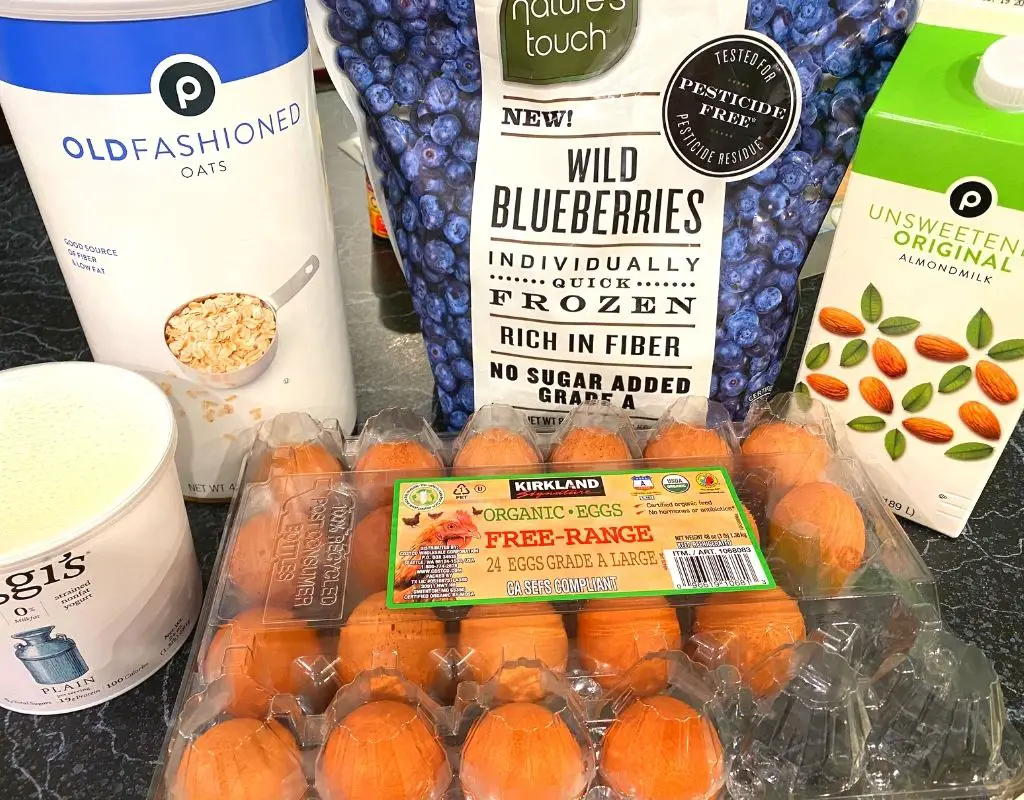
This program wouldn’t be complete without touching on nutrition. And this is where things can be a little.
Most people, especially in the world of fitness, bodybuilding, and all that’s related make nutrition more complicated than it should be. So I’m going make meal planning simple for you…
First, you need to understand that to efficiently build muscle and strength, your body needs a balance of all macronutrients:
- Protein
- Carbs
- Fats
Do not get caught up in the latest fad diet or whatever the current trend is. Some of those may have their place, and may actually work, to some extent.
But the problem is they’re just not feasible or sensible to follow. So you’ll end up constantly worrying about trying to stay aligned with that fad or trendy diet, and that will have an impact on your muscle and strength gains (and not a good one!).
**You may be wondering about specific ratios of macros and counting calories. I’m going to provide a sample meal plan below, which that mixed with your instinct should suffice.
However, if you want to dive deeper into macro ratios, you can read about that along with more meal planning strategies in this post: Meal Plans for Mass and Strength Gains
Secondly, let’s talk about is the best types of foods for building muscle and strength. So I’m going to provide you with a list of foods below that promote both, and then we’ll create a meal planning strategy based on these foods.
Foods for Building Muscle and Strength
**These are broken down by macronutrients (protein, carbs, fats). Some foods are listed twice, such as eggs, which are a great source of both protein and fat.
| Protein | Carbs | Fat |
|---|---|---|
| Eggs | Oatmeal | Eggs |
| Chicken/pork/beef | Whole grains | Nuts |
| Fish | Lentils/beans | Fatty fish |
| Tofu | Sweet potatoes | Beef |
| Milk/cheese | Fruits | Olive, coconut, peanut, sesame oil |
| Greek yogurt | Vegetables | Avocados |
Of course, these are more foods and most of these are listed at a general level. But that’s intentional because as I mentioned, I want to help you simplify your meal planning.
And if you want to keep your meal plan extremely simple, you could just pick one type of food from each macronutrient category and build a meal based on that.
For example, you may choose a meal that contains beef, vegetables, and olive oil. Or you may want eggs and oatmeal (eggs covers both protein and fats). Just make sure you’re eating adequate amounts of those foods for muscle gains, but not overeating.
**If you prefer a plant-based or vegan-friendly eating strategy, then read my post: How to Build Muscle on a Plant-based Meal Plan
1-Day Powerbuilding Meal Planning Strategy
Below you’ll find a sample meal plan. You can follow this exact plan or you can use it as a guide to create your own meal plan strategy.
The goal here is to give a template of a meal plan than you can stick to.
- You’ll eat a meal every 3-4 hours
- You can adjust the meal times and foods to cater to your schedule and liking
- Each meal includes a balance of protein, carbs, and fats
- This specific meal is based on morning workouts (you can read more on why I recommend morning workouts in this post: How Early Morning Workouts Can Help You Build More Muscle)
- You can add another meal if you wish as you may prefer eat a later meal before bed, especially if you’re trying to get more calories in that day
Here’s your powerbuilding meal plan…
Meal 1: 5:30 AM (pre-workout meal)
- 1 scoop of whey protein powder
- 8 ounces of almond milk
- 1 serving of oatmeal
- 1/3 cup of blueberries (mixed with the oatmeal)
**This is a lighter meal giving you some protein and slower digesting carbs with plenty of fiber (oatmeal) to give you sustainable energy during your workout.
***About 15-20 minutes after this meal, you can chug down your pre-workout drink. Be sure to read my post: Alpha Lion Superhuman Pre-workout Review
Meal 2: 8:30 AM (post-workout meal)
- 2 scoops of whey protein powder
- 8 ounces of almond milk
- 2 servings of fruit (ex: berries, a banana, pineapple, etc)
- 1/2 serving of natural peanut butter
- 5-7 grams of creatine monohydrate (this is optional, and we’ll talk more about supplement in the next section)
**The goal with your post-workout meal is to get fast-digesting protein and carbs. I personally add a little fat from the peanut butter as well typically take my multivitamin with this meal
Meal 3: 11:30 AM
- 8-10 oz of lean pork or chicken breast (cooked with olive or coconut oil)
- 1-2 servings of whole-grain rice
- 2 servings of mixed broccoli, cauliflower, and carrots
Meal 4: 3:00 PM
- 2 servings of Greek yogurt
- 1 serving of almonds and cashews
- 1 serving of pineapple
Meal 5: 6:30 PM
- 8-10 oz of steak or salmon
- 2 sweet potatoes
- 1 serving of beans or chickpeas
- 2 servings of mixed spinach and squash
Meal 6: 9:30 PM
**This is an optional meal and could be anything that’s high in protein with some healthy fats, and even some complex carbs. You don’t necessarily want simple carbs at this point, although some pineapple mixed with something like Greek yogurt can help you sleep.
But typically you would want something like eggs and oatmeal, or protein powder with some peanut butter, or even a little leftovers from your lunch or dinner.
Supplements for Powerbuilding
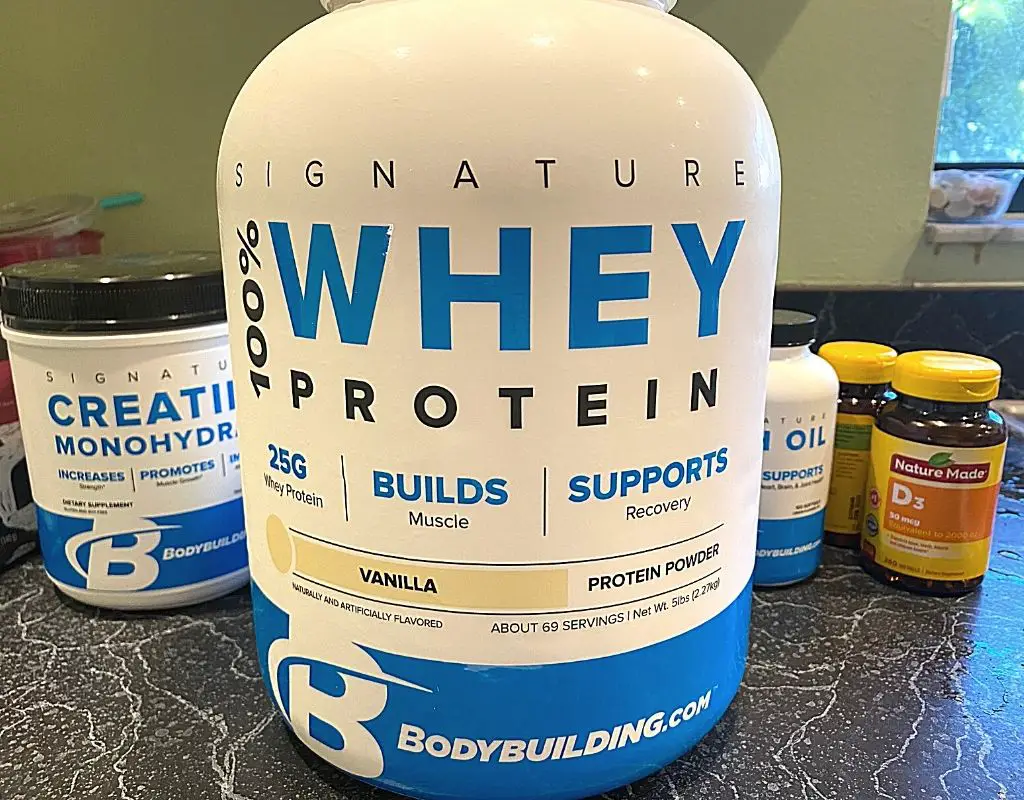
Do you need supplements to gain muscle mass?
Are supplements necessary for gaining strength?
The short answer is no. But there’s a caveat. If you’re not taking any supplements you had better be sticking to a super-strict meal plan.
And what I mean by strict meal plan is ensuring that you’re getting all of the vitamins, minerals, and other micronutrients you need to sustain your gym efforts.
All that said, I saved the supplement section for the end of this post. Add that’s simply because it’s the least of importance. And because if you’re not consistent in the basics of training and nutrition, supplements aren’t going to do you much good except for looking cool on the top of your fridge.
There are some supplements I recommend that can help you in your powerbuilding program here. They’re minimal, each has a specific purpose, and they’re not going to make you go broke.
Basic Supplements for Mass and Strength Gains
- Multivitamin
- Creatine
- Whey protein powder
- Natural testosterone booster
Multivitamins are to ensure you do not have any vitamin deficiencies. When you’re training hard, your body requires you to have essential vitamins for recovery and to keep your immune system up.
In fact, if you’re someone who gets sick often, I encourage you to read my post: Supplements that Boost Your Immune System
Creatine monohydrate is hands-down the absolute best muscle and strength building supplement you can take. And interestingly enough, it’s the least expensive. So that’s a no-brainer. Take creatine before and after your workouts.
Whey protein is an optional supplement, but if you’re like me, it’s just part of your grocery budget. The reason is it’s one of the purest and highest quality sources of fast-digesting protein making it perfect for your post-workout meal to start the recovery process.
Natural testosterone boosters go back to the issue that most athletes and bodybuilders have in regards to micronutrient deficiencies.
A quality test booster will include micronutrients like zinc, magnesium, and vitamin D. These are micronutrients that intense training will deplete you of, so it’s important to ensure you’re adding those back in.
You can read about the natural testosterone booster that I have been recommending for the past several years here: Jason’s TestoFuel Review – Why it Works.
**Don’t fall into the trap of taking so-called test boosters that have steroid-like names. Those are usually garbage and a waste of your money.
Stick to a high-quality natural testosterone booster as I mentioned, like TestoFuel.
Powerbuilding: Fastest Way to Gain More Size and Strength
So, is powerbuilding workouts the fastest way to gain more muscle size and strength?
The truth is there’s no magic formula to making gains. Yes, some workout programs are better than others. But if you put max effort into any program, you can expect some sort of results.
However, I do believe that these powerbuilding workouts do stand out among normal bodybuilding workout programs.
Why?
Because both have missing elements to them…
- Powerlifting = strength gains, but doesn’t promote muscle size or definition
- Bodybuilding = lean mass and ripped muscle, but runs the risk of making you ‘all show, no go’
Powerbuilding workouts take the best of both programs and give you both strength gains and ripped muscle mass.
I strongly (pun intended) encourage you to try one of my powerbuilding workout programs for at least 3 weeks.
**If you’re ready to commit to a full 12-week muscle-building system then check out my premium programs below:
Hardcore Muscle Building Program
Lean Muscle Building Program
Train with Passion,
Jason
